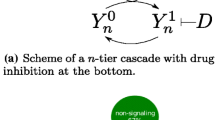Abstract
Processing of information by signaling networks is characterized by properties of the induced kinetics of the activated pathway components. The maximal extent of pathway activation (maximum amplitude) and the time-to-peak-response (position) are key determinants of biological responses that have been linked to specific outcomes. We investigate how the maximum amplitude of pathway activation and its position depend on the input and wiring of a signaling network. For this purpose, we consider a simple reaction A→B that is regulated by a transient input and extended this to include back-reaction and additional partners. In particular, we show that a unique maximum of B(t) exists. Moreover, we prove that the position of the maximum is independent of the applied input but regulated by degradation reactions of B. Indeed, the time-to-peak-response decreases with increasing degradation rate, which we prove for small models and show in simulations for more complex ones. The identified dependencies provide insights into design principles that facilitate the realization dynamical characteristics like constant position of maximal pathway activation and thereby guide the characterization of unknown kinetics within larger protein networks.
Similar content being viewed by others
References
Asthagiri, A. R., Reinhart, C. A., Horwitz, A. F., & Lauffenburger, D. A. (2000). The role of transient erk2 signals in fibronectin- and insulin-mediated dna synthesis. J. Cell Sci., 113(24), 4499–4510.
Behar, M., Hao, N., Dohlman, H., & Elston, T. (2007). Mathematical and computational analysis of adaptation via feedback inhibition in signal transduction pathways. Biophys. J., 93(3), 806–821.
Chen, J. R., Plotkin, L. I., Aguirre, J. I., Han, L., Jilka, R. L., Kousteni, S., Bellido, T., & Manolagas, S. C. (2005). Transient versus sustained phosphorylation and nuclear accumulation of erks underlie anti-versus pro-apoptotic effects of estrogens. J. Biol. Chem., 280(6), 4632–4638.
Cornish-Bowden, A. (1995). Fundamentals of enzyme kinetics. London: Portland Press.
Dayneka, N., Garg, V., & Jusko, W. (1993). Comparison of four basic models of indirect pharmacodynamic responses. J. Pharmacokin. Biopharm., 21, 457–478.
Dolmetsch, R. E., Lewis, R. S., Goodnow, C. C., & Healy, J. I. (1997). Differential activation of transcription factors induced by ca2+ response amplitude and duration. Nature, 386(6627), 855–858.
Gabrielsson, J., & Weiner, D. (1997). Pharmacokinetic/pharmacodynamic data analysis: concepts and applications, Stockholm: Swedish Pharmaceutical Press.
Gurdon, J. B., Standley, H., Dyson, S., Butler, K., Langon, T., Ryan, K., Stennard, F., Shimizu, K., & Zorn, A. (1999). Single cells can sense their position in a morphogen gradient. Development, 126(23), 5309–5317.
Heinrich, P. C., Behrmann, I., Haan, S., Hermanns, H. M., Müller-Newen, G., & Schaper, F. (2003). Principles of interleukin (il)-6-type cytokine signalling and its regulation. Biochem. J., 374(1), 1–20.
Heinrich, R., Neel, B. G., & Rapoport, T. A. (2002). Mathematical models of protein kinase signal transduction. Mol. Cell, 9(5), 957–970.
Kholodenko, B. (2006). Cell-signalling dynamics in time and space. Nat. Rev. Mol. Cell Biol., 7(3), 165–176.
Kholodenko, B. N., Demin, O. V., Moehren, G., & Hoek, J. B. (1999). Quantification of short term signaling by the epidermal growth factor receptor. J. Biol. Chem., 274(42), 30169–30181.
Kitano, H. (2002). Computational systems biology. Nature, 420(6912), 206–210.
Krzyzanski, W., & Jusko, W. (1997). Mathematical formalism for the properties of four basic models of indirect pharmacodynamic responses. J. Pharmacokinet. Biopharm., 25, 107–123.
Lauffenburger, D., & Linderman, J. (1993). Receptors: models for binding, trafficking, and signaling. Oxford: Oxford University Press.
Mager, D., Wyska, E., & Jusko, W. (2003). Diversity of mechanism-based pharmacodynamic models. Drug Metab. Dispos, 31, 510–519.
Marshall, C. J. (1995). Specificity of receptor tyrosine kinase signaling: transient versus sustained extracellular signal-regulated kinase activation. Cell, 80(2), 179–185.
Nguyen, H., & Peletier, L. (2009). Monotonicity of time to peak response with respect to drug dose for turnover models. C. R. Acad. Sci. Paris, 347(9–10), 495–500.
Peletier, L., Gabrielsson, J., & Haag, K. (2005). A dynamical systems analysis of the indirect response model with special emphasis on time to peak response. J. Pharmacokinet. Pharmacodyn., 32(3–4), 607–654.
Schilling, M., Maiwald, T., Bohl, S., Kollmann, M., Kreutz, C., Timmer, J., & Klingmüller, U. (2005). Computational processing and error reduction strategies for standardized quantitative data in biological networks. FEBS J., 272(24), 6400–6411.
Weisstein, E. (2008). Exponential integral. Tech. rep., MathWorld. http://mathworld.wolfram.com/ExponentialIntegral.html. Accessed 23 April 2010.
Wolkenhauer, O., & Mesarovic, M. (2005). Feedback dynamics and cell function: why systems biology is called systems biology. Mol. Biosyst., 1(1), 14–16.
Author information
Authors and Affiliations
Corresponding author
Additional information
F.J. Theis and S. Bohl contributed equally.
Electronic Supplementary Material
Rights and permissions
About this article
Cite this article
Theis, F.J., Bohl, S. & Klingmüller, U. Theoretical Analysis of Time-to-Peak Responses in Biological Reaction Networks. Bull Math Biol 73, 978–1003 (2011). https://doi.org/10.1007/s11538-010-9548-x
Received:
Accepted:
Published:
Issue Date:
DOI: https://doi.org/10.1007/s11538-010-9548-x




